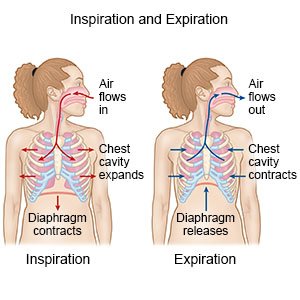How to Count Respirations
Medically reviewed by Drugs.com. Last updated on Aug 4, 2025.
Respirations are when you breathe in and out. Your respiratory, or breathing, rate is the number of times you breathe in and out in 1 minute. Most people breathe in and out 12 to 20 times every minute.
 |
DISCHARGE INSTRUCTIONS:
Why respirations are counted:
People who are ill, such as those with lung or heart disease, may need to have their respirations counted. The respiratory rate can show how the person's body is doing. A change in the respiratory rate may be a warning sign that the person's condition is getting worse.
How to count a person's respirations:
- Ask the person to sit upright.
- Try to count the other person's respirations without his or her knowing. If the person knows, he or she may try to control his or her breathing. This can give a false respiratory rate.
- Use a watch with a second hand and count his or her breaths for 60 seconds. Use any of the following methods to count:
- Look at his or her chest rise and fall. One rise and one fall are counted as 1 breath.
- Listen to his or her breaths.
- Place your hand on the person's chest to feel the rise and fall.
Contact the person's healthcare provider if:
- The person has a breathing rate that is less than 12 or more than 25.
- The person makes noise when he or she breathes, such as grunts, wheezes, or gurgles.
- The person feels dizzy or more tired than usual.
- The person has cold, clammy, sweaty skin.
Seek care immediately or call 911 if:
- The person has to sit upright to breathe or lifts his or her shoulders when he or she breathes in.
- The person purses his or her lips when he or she breathes.
- The person has retractions (pulling in of the skin between the ribs and around the neck with each breath).
- The person cannot speak because he or she has trouble breathing.
- The person has blue nails or lips.
- The person stops breathing.
- The person has a seizure.
- The person has a hard time staying awake or thinking clearly.
- The person has a fast heartbeat or chest pain.
© Copyright Merative 2025 Information is for End User's use only and may not be sold, redistributed or otherwise used for commercial purposes.
The above information is an educational aid only. It is not intended as medical advice for individual conditions or treatments. Talk to your doctor, nurse or pharmacist before following any medical regimen to see if it is safe and effective for you.
Further information
Always consult your healthcare provider to ensure the information displayed on this page applies to your personal circumstances.
